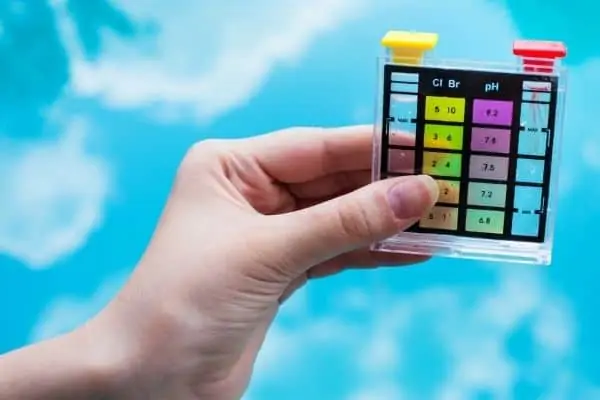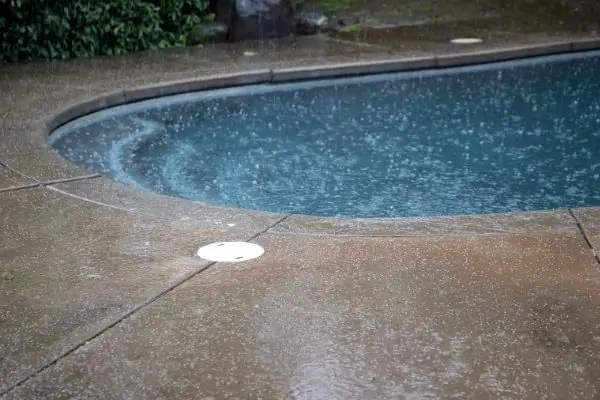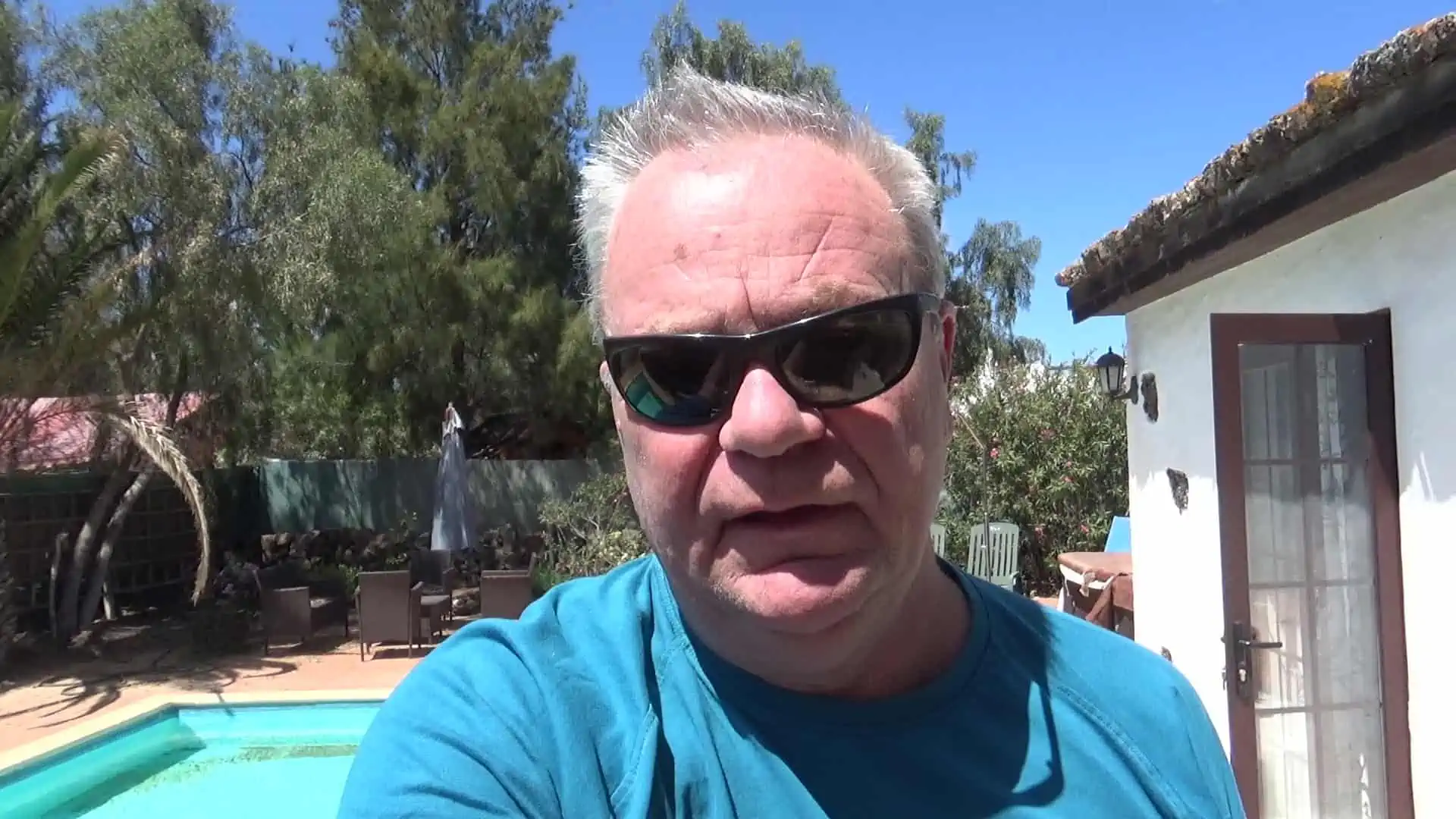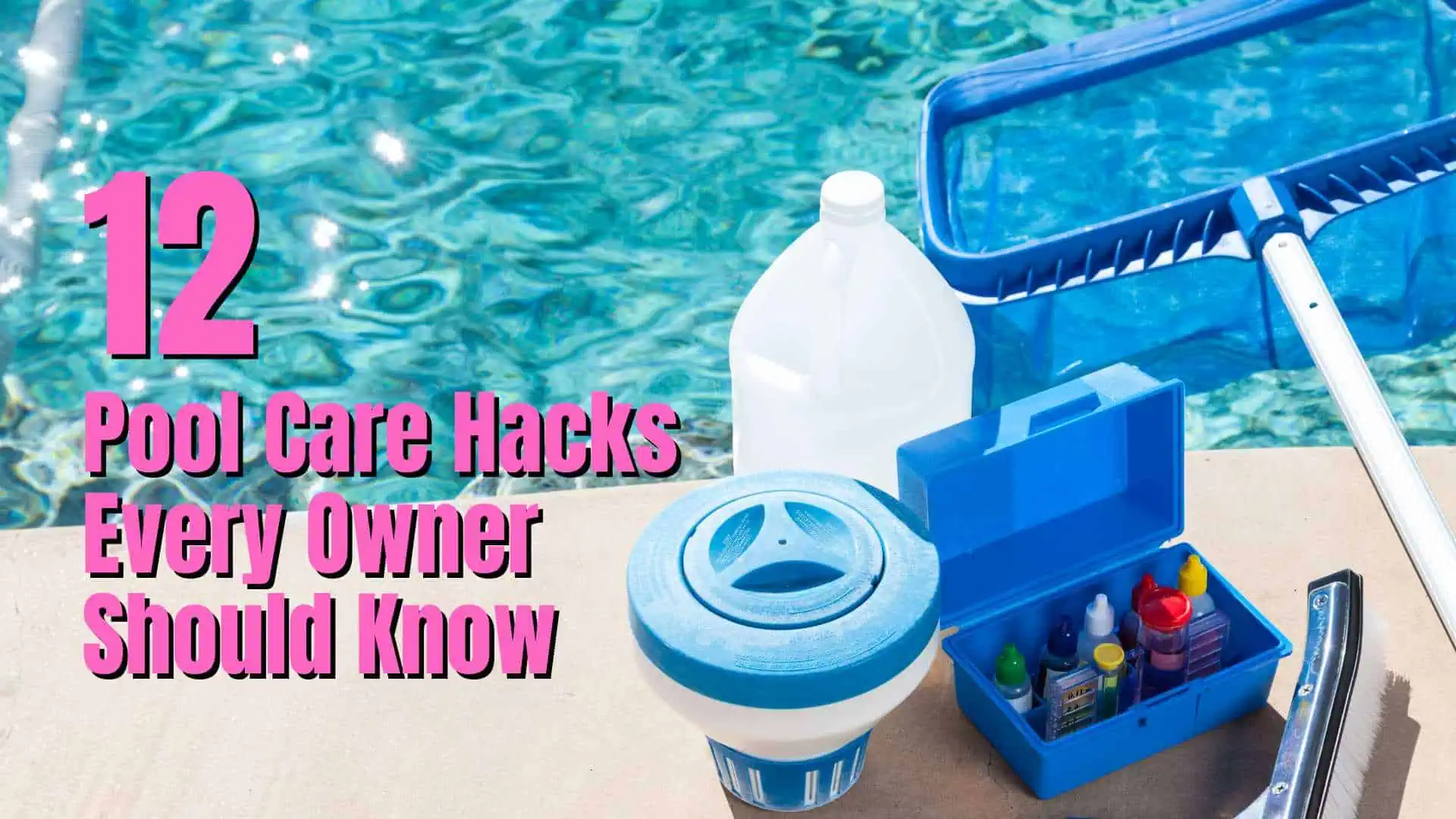Balancing pH in a pool is an integral part of maintenance and pool ownership. A variety of factors can lead to the pool’s pH becoming too low, causing various consequences to the pool, equipment, and swimmers.
When a pool’s pH is too low, it can:
- Corrode pool equipment
- Damage nearby materials
- Irritate the eyes and skin of swimmers
- Make chlorine less effective at disinfecting the pool
Low pH can be caused by a number of factors but is easily fixed by adding alkaline materials to the water.
For more specifics on the dangers of a low pH pool, as well as causes, and fixes, continue reading below.


What happens if pH is too low in pool
Low pH in a pool or any other body of water can cause some serious problems, but most often, they appear over a long period. pH is the chemical balance of something, in this case, the pool’s water. Ideally, pool water should have a pH level of 7.4 – 7.6, or be slightly alkaline. A neutral pH is 7.0 so in other words the ideal is slightly alkaline.
Anything below 7.4 can be considered low pH, but dangers and issues will typically only be noticeable below the 7.0 mark. Still, if you test your pool and find it below 7.4, you should take steps to raise it while it is a more straightforward task.
The consequences of a low pH pool affect the pool material, chlorine balance, equipment, and people who come into contact with the water. Most issues are easy to identify and fix on their own.
Corrode pool equipment
A low pH means that the water in the pool is slightly acidic. The lower the pH balance, the more acidic the water is. Generally speaking, acidic substances can cause corrosion, affecting all of the equipment touching the water.
Pool equipment and swimwear used in a low pH pool will wear faster than average and may experience bleaching. Expensive swimwear can quickly degrade to uselessness, and equipment like debris strainers and nets can have their service life reduced.
These effects are not immediate; a pool’s pH will never reach the point where it is instantly breaking or tearing apart equipment. However, the quicker degradation will generally mean that you need to replace items more often, and they will look worse, ultimately costing you more money.
Damage surface materials
The materials of the pool, such as the lining, tiles, and metals, also face corrosion from a low pH balance. This is especially dangerous for a few reasons:
- Materials can chip or tear
- Algae growth can become easier
If the mosaic tiles of a pool or the lining of a soft pool face too much degradation, they can chip or tear. This can cause serious safety concerns and may even ruin the pool as tiles break loose from walls, or the pool begins deflating.
Especially in tile pools, algae growth can become an issue. Algae grow more quickly on rougher surfaces where it can get a holding spot, such as tiles facing slight corrosion from low pH.
As with all dangers of a low pH value, these issues will get worse and more apparent the lower the pH balance is.
Cause irritation to the skin and eyes
Swimming in a low pH pool can cause red, itchy eyes and irritated skin. The water can become harsh and unpleasant to swim in, especially for people who enjoy diving underneath the water.
Most people have likely experienced this in their lives and know it is unpleasant – constantly needing to rub your eyes in the pool will also only make the problem worse.
Make chlorine less effective
When pH levels in a body of water get too low, it is harder to disinfect. Chlorine becomes less effective at dealing with germs at low pH levels. Simply put, the lower your pool’s pH level, the more chlorine you will need to put in to balance it.
Chlorine can already be an expensive maintenance cost for a pool, and needing to use it more than normal will certainly be a hit to the wallet. It will create a better pool experience and save money, in the long run, to invest in ways to fix the pool’s pH rather than constantly increasing chlorine usage.
What causes low pH in a pool?
There are various reasons why a pool’s pH level may lower too far and cause the water to become acidic. These causes are numerous but can generally be divided into three large categories, described in more detail below.
Each of them can cause damage to the pool’s pH, resulting in some of the dangers reviewed in the last section. In general, new materials added to the pool will cause the pH to change. This is true of everything; it only becomes an issue when enough materials have accumulated or entered the pool at the same time to affect the balance.
Maintaining a consistent knowledge of your pool’s pH is an excellent way to ensure that problems do not get out of hand. It is an especially good idea to test the water’s pH after some of the mentioned causes occur or when problems are detected.
Substantial rainfall

Substantial rainfall is one of the natural occurrences that can cause a pool’s pH to go down. Natural rainfall is slightly acidic, somewhere in the 5-5.5 range. Particularly low pH rain, known as acid rain, can be even lower.
If enough rainfall enters the pool, such as during torrential downpours or natural disasters like hurricanes, it can lower the pH of the water. Alternatively, if you have not checked the pool’s pH since getting significant and prolonged rainfall, it can also be lower.
Avoiding this can be challenging, especially if rainfall is simply accumulating over time like normal. Cover your pool if extreme rainfall is expected or, if you have time, before a natural disaster to prevent it.
Improper chemical usage
Maintaining pools requires plenty of chemicals, and all of these will affect the pH of the water. Ideally, if everything has been measured correctly and used in tandem, this should result in the proper pH of 7.4 – 7.6. However, sometimes things can go wrong, affecting the pH.
Improper chemical balancing can also result in a pool that is too basic; either issue will pop up during a routine pH check. Be careful when looking into solutions to balance and disinfect your pool. Most products will include proper usage terms and amounts on their label; it is best to follow them.
If you add chemicals to a pool to fix another issue that has appeared, measure the pH before and after. This should tell you whether or not the chemical is just replacing the first problem with another.
Overuse of the pool
As people enter the pool, we enter with us a host of different materials and composites that can affect the pool’s pH. Exterior sources such as lotions are an obvious sign, but even bodily fluids will affect the level.
Often, people using the pool will cause minimal changes in pH due to how large the body of water is.
Sometimes, however, changes can occur quickly. This is most likely to happen after months of continuous use or having many people in the pool at once.
There is little to be done to avoid this issue; instead, measuring the pH after having many swimmers around is best. That way, issues can be noticed and fixed before becoming larger.
How to raise the pH in a pool?
To raise the ph you need to add either soda ash (sodium carbonate) or baking soda (sodium bicarbonate).
Read my post How to raise pH in pool for details on how to do this.
Signs of low ph in pool
In order to check the pH of your pool to find out if your pH is low you will need one of three types of water testers:
- Test strips
- Test liquid
- Electronic tester
Test strips
These are small strips with different reactive agents on them that change color to give a reading of pH, total alkalinity, chlorine levels etc. Some strips just test 4 different readings while others test as many as 7 different things. You dip them in the pool water for 20 seconds or so and then compare the colors to the scale on the package to find out what your readings are.
These Aquachek 7 way pool and spa test strips available on Amazon check for total hardness, total Chlorine, free Chlorine, Bromide, total alkalinity, pH and Cyanuric Acid. I suggest you buy them in bulk as you they are one use only and you will use many of them.
Test liquid
Pool water test liquids work in much the same way as the test strips except that you place some pool water in the test tubes and then add reactive liquid agents to the water which changes color to give a reading you check against a chart next to each tube.
The Poolmaster Water Chemistry 5-Way Swimming Pool Test Kit is available on Amazon.
Electronic tester
Electronic water testers are more expensive than test strips or liquids but they are a one-off cost. They also have an advantage for anyone who is color blind as you do not need to match colors as you simply read the display.
A popular unit on Amazon is the Aqua Chek Trutest Digital Reader which reads free Chlorine, Bromine, pH and total alkalinity. You can easily test to see if your pH is too low using this device.
Pool Care Handbook and Video Course
When I bought my house with a swimming pool, I knew absolutely nothing about pool care. I just winged it for a while, making many mistakes along the way.
Fortunately, I was recommended Swim University’s Pool Care Handbook and Video Course. I bought it and it was an absolute game-changer.
It was the best money I spent that year. I learned everything from basic cleaning to advanced troubleshooting. Swim University offers a no-quibble refund policy too so what do you have to lose?
Recap
When a pool’s pH is too low, it can cause issues affecting swimmers, equipment, chlorine effectiveness, and even the tiles and lining of the pool itself. A standard pool pH level is between 7.4 and 7.6. Read my other article if your pH is too high.
Common causes for pH lowering include natural occurrences like rainfall, improper chemical balance, and overuse. As more foreign substances enter the pool, pH levels inevitably change, so keeping an eye on them is a good idea. Read about shocking your pool.
You may also find my post useful – What does baking soda do to a pool?
My top 3 pool cleaning tools
These are the pool cleaning tools I have found the most useful since I have had my pool.
Step and corner vacuum brush
This is a really useful tool for getting into the areas that a standard vacuum head simply cannot reach. Aquatix Pro Pool Step & Corner Vacuum Brush
Leaf rake net
If, like me, you get plenty of leaves at the bottom of your pool then a good leaf rake/net is a must. The Stargoods Pool Skimmer Net gets under the leaves easily.
Robotic pool cleaner
These are quite expensive and it was a number of years before I bit the bullet and bought one. I have never regretted it. The Dolphin Nautilus CC Plus is the most recommended pool cleaning robot on all of the pool forums. It not only cleans the bottom of the pool but also the sides and the waterline.

I have had hot tubs for over 20 years and a pool for the last 10 years. I had to learn how to clean, maintain and fix them the hard way. Since then I have helped many friends and neighbors with their pools and now I want to share everything I have learned with you. About Me







